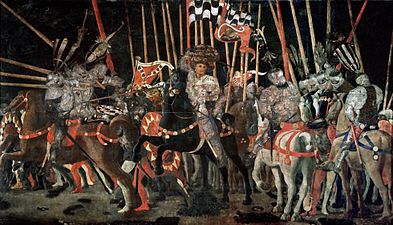The Battle of San Romano
| The Battle of San Romano | |
|---|---|
Musée du Louvre |
The Battle of San Romano is a set of three paintings by the
Subject
The three paintings are:
-
Niccolò Mauruzi da Tolentino at the Battle of San Romano (probably c. 1438–1440), egg tempera with walnut oil and linseed oil on poplar, 182 × 320 cm, National Gallery, London.[2]
-
Niccolò Mauruzi da Tolentino unseats Bernardino della CardaGalleria degli Uffizi, Florence
-
The Counterattack ofMusée du Louvre, Paris
The Uffizi panel was probably designed to be the central painting of the triptych and is the only one signed by the artist. The sequence most widely agreed among art historians is: London, Uffizi, Louvre, although others have been proposed. They may represent different times of day: dawn (London), mid-day (Florence) and dusk (Paris) – the battle lasted eight hours.
In the London painting, Niccolò da Tolentino, with his large gold and red patterned hat, is seen leading the Florentine cavalry. He had a reputation for recklessness, and doesn't even wear a helmet, though he sent two messengers (the departure of the two messengers, depicted centre, top) to tell his allied army of Attendolo to hurry to his aid as he is facing a superior force.[4] In the foreground, broken lances and a dead soldier are carefully aligned into orthogonals, so as to create an impression of perspective. Similar to that of a tapestry, the landscape rises up in a picture plane as opposed to receding deeply into space. This illusion of a backdrop and a perspective theme resembling a stage, depicts the war as a theatrical ceremony.[5] The three paintings were designed to be hung high on three different walls of a room, and the perspective designed with that height in mind, which accounts for many apparent anomalies in the perspective when seen in photos or at normal gallery height.
Many areas of the paintings were covered with gold and silver leaf. While the gold leaf, such as that found on the decorations of the bridles, has remained bright, the silver leaf, found particularly on the armour of the soldiers, has oxidized to a dull grey or black. The original impression of the burnished silver would have been dazzling. All of the paintings, especially that in the Louvre, have suffered from time and early restoration, and many areas have lost their modelling.[2]
The panels were a subject in the BBC series The Private Life of a Masterpiece (2005).
References in popular culture
The dark horse in the Louvre panel, mounted by Micheletto Attendolo (da Cotignola), can be seen painted in a tapestry, in the first segment ("Metzengerstein") of the 1968 omnibus film Spirits of the Dead. In the 4th Episode (Lucrezia's Wedding) of the 2011 TV Series The Borgias, the London and Louvre panel is shown adorning the dining hall walls of the Florentine Prince when cardinal Della Rovere visits him in Florence.
See also
| External media | |
|---|---|
| Audio | |
| Video | |
- Italian Renaissance painting
- Funerary Monument to Sir John Hawkwood
- Equestrian Statue of Niccolò da Tolentino
- The Annunciation and Seven Saints by Filippo Lippi, also from the decoration of Palazzo Medici
- 100 Great Paintings
References
- ^ Paolo Uccello The Battle of San Romano NG583
- ^ ISBN 1-85709-293-7
- ^ «and not Ciarda, as he is often referred to" (Lorenzo Sbaraglio, Paolo di Dono, detto Paolo Uccello, in Dizionario Biografico degli Italiani - Volume 81 - 2014).
- ^ Private Life of a Masterpiece, BBC TV
- ISBN 9780205685172.)
{{cite book}}: CS1 maint: multiple names: authors list (link - ^ "Personal response: Serena Ferrente". National Gallery. Archived from the original on April 19, 2015. Retrieved December 31, 2012.
- ^ "Uccello's The Battle of San Romano". Smarthistory at Khan Academy. Retrieved December 31, 2012.
Further reading
- Harrington, Peter, "Military history's loss is Art History's Gain," Quarterly Journal of Military History, Vol. 16, No. 1, Autumn 2003, pp. 44–49.
- Starn, Randolph and Loren Partridge, "Representing war in the Renaissance: The shield of Paolo Uccello," Representations, No. 5, Winter 1984, 33–65.
External links
![]() Media related to San Romano Battle (Paolo Uccello) at Wikimedia Commons
Media related to San Romano Battle (Paolo Uccello) at Wikimedia Commons

![Niccolò Mauruzi da Tolentino at the Battle of San Romano (probably c. 1438–1440), egg tempera with walnut oil and linseed oil on poplar, 182 × 320 cm, National Gallery, London.[2]](http://upload.wikimedia.org/wikipedia/commons/thumb/9/98/San_Romano_Battle_%28Paolo_Uccello%2C_London%29_01.jpg/398px-San_Romano_Battle_%28Paolo_Uccello%2C_London%29_01.jpg)
![Niccolò Mauruzi da Tolentino unseats Bernardino della Carda[3] at the Battle of San Romano (dating uncertain, c. 1435–1455), tempera on wood, 182 × 320 cm, Galleria degli Uffizi, Florence](http://upload.wikimedia.org/wikipedia/commons/thumb/d/df/La_batalla_de_San_Romano%2C_por_Paolo_Uccello.jpg/399px-La_batalla_de_San_Romano%2C_por_Paolo_Uccello.jpg)
